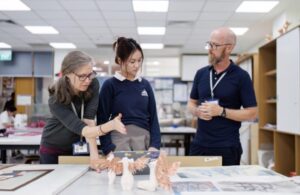Technology transforms the classroom into a space where curiosity, creativity, and critical thinking thrive. Instead of passively absorbing information, students engage deeply with content, collaborate effectively with peers, and gain future-ready skills. For parents exploring international school options, choosing a learning environment that integrates educational technology ensures that children stay ahead—academically and in life.
What are the Benefits of Using Technology in the Classroom?
Technology enhances the way students experience learning. It makes lessons more interactive, allows for greater personalization, and connects classroom knowledge to the world outside school. When used with intention, it supports teachers while empowering students to take ownership of their learning. From early childhood through the final years of secondary school, technology helps students build essential skills, explore new ideas, and develop the confidence to succeed in a changing world. The following benefits show how effective classroom technology can shape a richer, more relevant educational experience.

1. Transform Lessons with Interactive Tools
Interactive tools bring subjects to life. Smartboards, apps, and digital simulations let students explore concepts actively, making learning feel like discovery. Whether they’re using an app to visualize geometry in 3D or participating in a science experiment on-screen before replicating it in class, these tools make abstract content tangible.
Interactive learning builds motivation. Children often feel more invested when they receive instant feedback or control their pace. These small wins—solving a challenge on a gamified math platform or completing a storytelling activity—boost confidence and reinforce core concepts through practice and play.
At the International School Ho Chi Minh City (ISHCMC), interactive technology plays a vital role in engaging young minds. In the early years, for example, teachers introduce digital tools that support language development and foundational math in an age-appropriate way. These experiences help set the stage for a lifelong love of learning, making ISHCMC a standout choice for families searching for a preschool in Vietnam that nurtures creativity and inquiry from day one.
2. Personalize Learning to Empower Student Growth
Technology makes personalized learning not just possible, but scalable. Adaptive platforms adjust to students’ responses in real time, presenting new content when learners are ready and revisiting concepts when more practice is needed. This keeps students in the optimal zone—challenged, yet supported.
Teachers benefit from real-time insights. They can quickly identify learning gaps, review patterns in student performance, and adjust strategies. This data-driven approach results in timely interventions and more effective teaching.
At ISHCMC, personalized learning extends into every classroom. Students in the Primary Years Programme (PYP) and Middle Years Programme (MYP) set their own learning goals using technology-enabled tracking systems. They receive personalized guidance, but more importantly, they gain tools to reflect on their own growth. This ownership helps students develop into confident, independent learners.
3. Build Future-Ready Skills with Digital Fluency
The ability to navigate digital tools effectively is no longer optional. From coding and digital storytelling to data interpretation and virtual collaboration, schools must prepare students to operate confidently in a tech-driven world.
Integrating these skills early helps students think critically and act creatively. Whether they’re writing code, designing presentations, or editing videos, learners gain more than technical know-how—they learn to problem-solve, ideate, and communicate clearly.

At ISHCMC, students start building digital fluency from the primary years and expand those skills through interdisciplinary projects in the middle and upper years. Success stories speak for themselves. One student built a prototype bicycle that caught the attention of McLaren. Another launched a thriving clothing business while still in school. These achievements reflect the school’s belief in innovation-driven learning.
4. Apply Knowledge in Real-World Contexts
Technology supports project-based learning, where students apply classroom knowledge to real-world challenges. With tools like research databases, virtual labs, and AI-powered writing assistants, learners go beyond surface-level answers to explore deeper ideas.
This blend of theory and practice helps students retain information. A lesson on sustainability, for example, becomes more meaningful when students create video campaigns or design eco-friendly products using digital tools.

At ISHCMC, real-world learning is embedded in the curriculum. Students regularly work on interdisciplinary projects that combine science, literature, art, and technology. They develop solutions, pitch ideas, and receive feedback—just like professionals. This process builds resilience and a sense of purpose.
5. Strengthen Collaboration through Digital Platforms
Collaboration doesn’t end with group work at a table. With technology, students collaborate across classrooms and time zones. Platforms like shared docs, learning management systems, and project boards allow seamless coordination and meaningful peer feedback.
These digital interactions build communication, accountability, and empathy. Students learn how to divide tasks, listen to diverse opinions, and present their thinking clearly—skills essential for any future career.
At ISHCMC, MYP and DP students use collaborative tools to manage long-term projects in arts, business, and science. Whether preparing for the Model United Nations or launching a student-led service campaign, students rely on technology to organize, reflect, and deliver impactful outcomes.
6. Ensure Continuity with Flexible Learning Tools
Blended learning models—where digital content supports traditional instruction—give students more control over how and when they learn. Whether reviewing lessons from home or exploring advanced topics at their own pace, learners develop independence and self-regulation.
Tech integration also ensures learning continues during disruptions. During school closures or travel, students with access to structured online environments keep progressing without missing key milestones.
ISHCMC’s digital infrastructure supports both flexibility and structure. Students in secondary school receive MacBooks and use cloud platforms to submit assignments, join discussions, and collaborate on group projects. These tools became especially valuable during periods of home-based learning, allowing students to thrive in virtual settings without losing momentum.
Challenge Teen Minds Through Tech-Driven Innovation
For teenagers, technology becomes a tool for leadership and innovation. ISHCMC’s MYP and DP students use AI, digital modeling, and data tools to create original solutions—often tied to social impact or entrepreneurship.
Students pursue projects that matter to them. One developed an app to promote mental health. Another launched a community program using digital tools to map clean water sources. These experiences deepen engagement and prepare teens for the demands of university and beyond.
The school’s environment encourages experimentation, risk-taking, and strategic thinking. With expert guidance, students learn to ask better questions and design thoughtful answers—traits highly valued by universities and future employers. Families looking for secondary schools in Vietnam that prioritize academic growth and innovative thinking will find ISHCMC a compelling option.
Choose Schools that Lead with Innovation
Technology alone doesn’t make a school innovative—it’s how the tools are used to enrich the student experience. Parents seeking schools that lead with purpose should look for those where technology aligns with inquiry, creativity, and real-world application.
At ISHCMC, technology supports the full student journey—from early exploration to university pathways. Through interactive lessons, personalized learning, and authentic problem-solving, students develop into capable, compassionate leaders prepared for a world that demands more than academic excellence.
Want more insights? Keep visiting Lotology for the latest updates and information!
